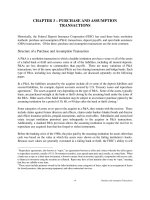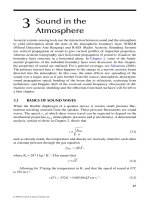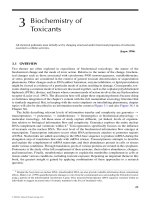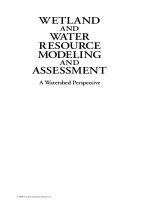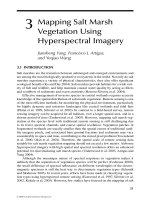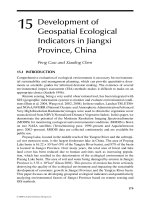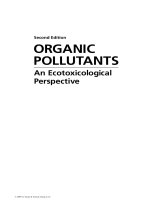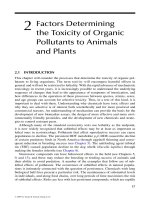ORGANIC POLLUTANTS: An Ecotoxicological Perspective - Chapter 3 ppt
Bạn đang xem bản rút gọn của tài liệu. Xem và tải ngay bản đầy đủ của tài liệu tại đây (219.57 KB, 7 trang )
67
3
Influence of the
Properties of
Chemicals on Their
Environmental Fate
Chapter 2 was concerned with processes that determine the distribution of chemicals
within living organisms and the relationship between distribution and toxicity. The
importance of properties of chemicals in determining their fate within living organ-
isms was given emphasis. Polarity, molecular size, the presence of functional groups,
and molecular stability were all seen to inuence toxicokinetic processes. The types
of enzymes responsible for biotransformations were related to the structures of the
chemicals undergoing biotransformation (e.g., esterases for esters, reductases for
nitro compounds, monooxygenases for aromatic hydrocarbons, etc.). This chapter
will consider the wider question of how the properties of chemicals determine their
fate in the gross environment, and how these properties can be incorporated into
descriptive and predictive models relating to the movement and distribution of envi-
ronmental chemicals.
First, there will be a description of chemical and physical properties that deter-
mine the fate of organic pollutants in the gross environment, restricting the discus-
sion to chemical and physical processes. Next, an account is given of how these data
are incorporated into models that attempt to describe or predict environmental fate.
Finally, the relationship between the properties of chemicals and the operation of
biological processes that determine environmental fate will be discussed. Drawing
on the background given in Chapter 2, emphasis will be given to the relationship
between properties of environmental chemicals and their uptake excretion and
metabolism by living organisms. The overall aim will be to lay a proper foundation
for consideration of the more complex issues in Chapter 4, which will address the
question of movement and distribution of chemicals in ecosystems where both bio-
logical and abiotic processes come into play. Key issues will be the fate of chemicals
in soils and the movement of chemicals along terrestrial and aquatic food chains,
situations in which fate is determined by both biological and chemical processes.
© 2009 by Taylor & Francis Group, LLC
68 Organic Pollutants: An Ecotoxicological Perspective, Second Edition
3.1 PROPERTIES OF CHEMICALS THAT INFLUENCE
THEIR FATE IN THE GROSS ENVIRONMENT
Polarity is one of the most important determinants of the environmental fate of
organic chemicals. In general, the more polar a compound, the higher its water sol-
ubility and the lower its octanol–water partition coefcient (K
ow
). Conversely, the
less polar a compound, the lower its water solubility and higher its K
ow
(see earlier
discussion in Chapter 2, Section 2.3.1). K
ow
is a measure of “hydrophobicity,” and
is regarded as one of the most valuable indicators of the environmental behavior
of organic chemicals. Many examples will be given in the chapters dealing with
individual pollutants in the second part of this text. (For more detailed and critical
discussion about the determination and utilization of K
ow
values, readers are referred
to the chapter by Connell in the work by Calow 1994.)
Hydrophobic compounds tend to be excluded from the aqueous phase of the envi-
ronment owing to what has been termed the hydrophobic effect (Tanford 1980). Polar
water molecules are drawn together because of the attraction of d+ and d− charges on
adjacent molecules. Hydrophobic compounds present in water, which have little or
no charge, are thereby “squeezed out.” In soils and sediments, they tend to become
adsorbed to the surface of colloidal material—organic matter and clay—where they
are retained by van der Waals forces. In surface waters, they tend to move to the sur-
face (into surface oil lms, where present), into sediments, or into the waxy cuticle
of aquatic macrophytes. The tendency of hydrophobic compounds to bind to colloid
surfaces has two important consequences: (1) they are not very mobile and (2) they
are often very persistent because they are not freely available to the enzyme systems
(e.g., of microorganisms) that can degrade them. In soils, as in terrestrial animals,
refractory hydrophobic molecules tend to be markedly persistent. Of the examples
given in Table2.1 (Chapter 2), dieldrin and p,pb-DDT with K
ow
values of 5.48 and
6.36, respectively, have very long half-lives in soils and sediments.
Another very important factor determining the distribution of chemicals in the
gross environment is vapor pressure. It is dened as the pressure exerted by a chemi-
cal in the vapor state on its own liquid or solid surface at equilibrium. It may be
expressed as millimeters of mercury (torr), as a fraction of normal atmospheric pres-
sure (760 mm Hg), or as pascals (Pa; 1 Pa = 0.0075 mm Hg). Vapor pressure is
related to temperature, and liquids boil at temperatures that raise their own vapor
pressures to 760 mm Hg. Water, for example, boils at 100°C. Some solids sublime—
that is, they pass directly into the vapor state without liquefying. Many pesticides that
exist in the solid state under normal temperature and pressure will sublime under
eld conditions. Volatilization represents a major source of loss of pesticides from
the surface of crops and from the soil. With pollutants, high vapor pressure gener-
ally indicates that chemicals will tend to move into the atmosphere, with the atten-
dant risk that they will be transported over large distances if they are stable enough.
Chlorouorocarbons (CFCs) present a striking example of the problem. They are
highly volatile, and stable enough to reach the ozone layer within the stratosphere.
Once there, however, they can reduce the concentration of ozone by interacting with
it, an environmental process that is thought to have signicantly reduced the extent
of the ozone layer. The long-range movement of certain polychlorinated biphenyls
© 2009 by Taylor & Francis Group, LLC
Influence of the Properties of Chemicals on Their Environmental Fate 69
(PCBs) and organochlorine insecticides into polar regions has been attributed to aer-
ial transport in the vapor state. In the second part of the book, examples will be given
of pollutants that move readily into the air because of relatively high vapor pressure.
Much of the earth’s surface is water, and an important aspect of the volatiliza-
tion of pollutants is their movement from water to air. The movement of solutes
between water and air is governed by Henry’s law, which states that at equilibrium,
the concentration of a chemical in the vapor state bears a constant relationship to the
concentration in aqueous solution.
Hb = Conc.air/Conc. water = [n/V][1/S] = P/RTS
where Hb is a partition coefcient, n/V is the molar concentration of the vapor, S is
the saturation solubility of the solute in water, P is vapor pressure, R is the universal
gas constant, and T is the absolute temperature.
This equation can be simplied to give H = P/S, where H is now Henry’s law
constant, which has dimensions of atm m
3
/mole. Values for H may be calculated or
measured (Mackay et al. 1979), and are now widely used in fugacity modeling (see
Section 3.2).
Another important determinant of the environmental fate of pollutants is their
chemical stability. Environmental chemicals that are highly resistant to chemical
degradation have been described as being “refractory,” or “recalcitrant” (see Crosby
1998). Many such chemicals are not very photochemically stable. When exposed
to solar radiation, they may be oxidized or may undergo molecular rearrangement.
Some chemicals, for example, organophosphates (OPs), carbamates, and pyrethroids,
are susceptible to hydrolysis, especially when exposed to water having high pH. By
contrast, other compounds only undergo very slow degradation and can therefore
be transported over large distances in air or water without substantial loss, unless
biodegradation is signicant (see Section 3.3). Typical examples are certain highly
halogenated compounds such as p,pb-DDE, dieldrin, higher chlorinated PCBs, and
TCDD (dioxin). Highly halogenated compounds tend to be resistant to oxidation and
other mechanisms of chemical degradation.
In most cases, chemical instability of pollutants limits risk to the environment
because it usually represents a reduction in toxicity. There are, however, exceptions
and the devil may be found in the detail. When dieldrin residues are exposed to solar
radiation, there is some conversion to the persistent and highly toxic photodieldrin.
When the OP malathion is stored under hot conditions over long periods, it is con-
verted to highly toxic isomalathion. When polycyclic aromatic hydrocarbons (PAHs)
are exposed to radiation, they are converted into products that are highly toxic to
sh. Such examples illustrate the dangers of hasty or supercial judgment in envi-
ronmental risk assessment, and the importance of rigorous case-by-case analysis.
Another factor that can inuence the environmental distribution of a chemical
is the presence of charged groups. Some pollutants, such as the sodium or potas-
sium salts of phenoxyalkanoic herbicides, dinitrophenols, and tetra- or penta-chlo-
rophenol, exist as anions in solution. Others, such as the bipyridyl herbicides diquat
and paraquat, are present as cations. In either case, the ions may become bound to
organic macromolecules or minerals of soils or sediments that bear the opposite
© 2009 by Taylor & Francis Group, LLC
70 Organic Pollutants: An Ecotoxicological Perspective, Second Edition
charge. Thus, the paraquat cation can be strongly bound (adsorbed) to negatively
charged surfaces within clay minerals, in competition with exchangeable cations
such as Ca
2+
, K
+
, and Na
+
. It can also be bound to ionized carboxyl or phenolic
groups of soil organic matter. Organic anions may bind to certain positively charged
groups within soils and sediments. The inuence of chemical properties on environ-
mental fate is dealt with in much more detail in specialized texts on environmental
chemistry, such as those by Schwarzenbach et al. (1993) and Crosby (1998).
3.2 MODELS OF ENVIRONMENTAL FATE
Confronted with the complexity of environmental pollutants and the great expense
of actually measuring the levels of organic pollutants, the attractions of developing
models for environmental fate are obvious. Because of the restraints of cost and time,
the determination of actual levels of pollutants in different compartments of the
environment can only be carried out to a very limited degree. Many different models
have been developed that attempt to describe or predict the fate of chemicals in the
gross environment. (For a detailed treatment of the subject, readers are referred to
Mackay 1991, Mackay 1994, Jorgensen 1990, and Bacci 1994.) They range from
limited single-media models, which are concerned with the fate of a chemical in a
phase such as air, water, or soil, to wide-ranging multimedia models, which attempt
to describe the movement of chemicals through different phases of the environment
across a very large area over distances as great as thousands of kilometers across.
The former may be expected to provide reasonably close estimates of environmental
concentrations if the data base is good enough, whereas the latter can only give a
broad and imprecise view of distribution through air, soil, water, sediment, and biota
on what is approaching a global scale. Some multimedia models are only useful for
ranking chemicals according to their tendency to move into particular environmen-
tal compartments (e.g., air), and cannot give reliable estimates of concentrations that
will be found in the real world following dened releases of chemicals. There are
too many uncontrolled variables such as temperature, wind speed, solar radiation,
precipitation of rain and snow, etc. The term evaluative models is sometimes used to
describe such systems (Bacci 1994). In certain cases, the multimedia approach has
been applied to global pollution problems; for example, the geochemical cycling of
CO
2
and the distribution of CFCs, which may affect the ozone layer.
Multimedia models can describe the distribution of a chemical between envi-
ronmental compartments in a state of equilibrium. Equilibrium concentrations in
different environmental compartments following the release of dened quantities of
pollutant may be estimated by using distribution coefcients such as K
ow
and H’s (see
Section 3.1). An alternative approach is to use fugacity (f) as a descriptor of chemical
quantity (Mackay 1991). Fugacity has been dened as the tendency of a chemical to
escape from one phase to another, and has the same units as pressure. When a chemi-
cal reaches equilibrium in a multimedia system, all phases should have the same
fugacity. It is usually linearly related to concentration (C) as follows:
f = C/Z
© 2009 by Taylor & Francis Group, LLC
Influence of the Properties of Chemicals on Their Environmental Fate 71
where Z is a constant, sometimes termed the fugacity capacity constant. Values for
Z depend on the chemical, nature of the absorbing medium, and temperature.
Examples of models of the environmental fate of chemicals, utilizing partition
coefcients and fugacities, are given in the works cited earlier, and also in Chapter 3
in Walker et al. (2000, 2006).
3.3 INFLUENCE OF THE PROPERTIES OF CHEMICALS
ON THEIR METABOLISM AND DISPOSITION
Up to this point, the discussion has been limited to the inuence of chemical proper-
ties on the physical processes that inuence distribution of the chemical through the
environment without taking account of their effects on those biological processes
that also affect movement. Although it is true that biological factors have little or no
inuence on the fate of chemicals transported by air, this is not the case with trans-
port by surface waters or in sediments or soils. In the latter case, living organisms are
involved in the uptake, metabolism, and transfer of organic pollutants. Stable pollut-
ants are transported over considerable distances by migrating animals and birds, and
move through terrestrial and aquatic food chains. Such complexities are not readily
accommodated by the relatively simple “chemical” models described earlier.
In Chapter 2, the fate of organic pollutants in living organisms and the processes
involved were described. In this section, the relationship between the properties of
chemicals and the operation of those processes will be briey reviewed. Many exam-
ples of the inuence of properties of a chemical on its own metabolic fate will be
encountered in Part 2 of this book.
Once again, the hydrophobicity of compounds is a critical determinant of their
fate. Compounds with high K
ow
values tend to undergo bioaccumulation by animals,
because they move from the aqueous phase into the hydrophobic environment of
fat depots and biological membranes. Water-soluble compounds do not have this
tendency. Aquatic organisms do not tend to bioconcentrate them. When terrestrial
animals absorb them from food or water, they are usually rapidly excreted in their
unchanged forms. With lipophilic compounds, however, rapid elimination from
the body depends on efcient metabolism to water-soluble and readily excretable
metabolites and conjugates. This trend is particularly marked in terrestrial animals;
aquatic species can lose lipophilic compounds to some extent by “exchange diffu-
sion.” Interestingly, in comparison with terrestrial animals, aquatic animals gener-
ally have relatively low levels of detoxifying enzymes such as cytochrome P450s of
family 2, presumably because they have less need of them. Fish, for example, have
considerably lower levels of such enzymes than omnivorous terrestrial animals and
birds (Chapter 2, Walker 1978, 1980).
Many of the lipophilic pollutants described here are not persistent along food
chains because they are readily biodegradable by terrestrial vertebrates. The main
exceptions are polyhalogenated compounds such as some organochlorine (OC)
insecticides, higher halogenated PCBs and PBBs, PCDDs, and PCDFs. As men-
tioned earlier, the main mechanism of primary metabolism of these compounds
is P450-catalyzed attack. The problem is that highly halogenated compounds are
© 2009 by Taylor & Francis Group, LLC
72Organic Pollutants: An Ecotoxicological Perspective, Second Edition
resistant to such oxidative attack. Thus, polyhalogenated compounds of this type
present a general problem of persistence and have long biological half-lives in most
animals, terrestrial or aquatic. They are, therefore, liable to undergo biomagnica-
tion with movement along food chains, and also to survive transportation over long
distances in migrating animals (e.g., sh or whales) and birds. Some organometallic
compounds (e.g., methyl mercury) are also very persistent in terrestrial vertebrates,
and are only slowly metabolized.
Some compounds that are readily and rapidly metabolized and excreted by ter-
restrial vertebrates degrade only very slowly in other species, for example, marine
invertebrates such as bivalve mollusks. The general question of major differences
between species and groups in metabolic capacity will be discussed in Chapter 4,
Section 4.1. At this stage, the critical point is that there are compounds (such as
PAHs) that tend to bioconcentrate/bioaccumulate in certain species low in aquatic
food chains that are rapidly metabolized by sh, mammals, and birds occupying
higher trophic levels. Thus, unlike many polyhalogenated compounds, they are not
biomagnied as they move to the top of the food chain. This illustrates the limi-
tations of using standard laboratory species such as rats, mice, or Japanese quail
as metabolic models in ecotoxicology. There are many chemicals that are rapidly
metabolized by these species, which are recalcitrant and consequently persistent in
certain aquatic invertebrates (Livingstone 1991; Walker and Livingstone 1992).
The biotransformation of lipophilic pollutants into water-soluble and readily
excretable products represents the main mechanism for their elimination by terres-
trial animals. Its effectiveness, however, depends on the availability of the pollutants
to the relevant enzymes. Where pollutants are stored in fat reserves, they usually
become available to the liver in course of time, with the mobilization of lipids.
Rates of elimination depend on rates of mobilization of fat reserves. The very strong
binding of pollutants to proteins can severely limit the availability of chemicals to
enzyme systems or for direct excretion, and can result in very long biological half-
lives. Examples include the binding of superwarfarins to liver proteins (Chapter 11)
and the binding of hydroxymetabolites of PCBs to plasma proteins (see Chapter 6,
Section 6.2.4). Such long-term binding is limited by the number of available binding
sites and, in the examples given, only relates to the persistence of low concentrations
of chemical. Higher concentrations are freely available for metabolism or excretion.
The refractory nature of some pollutants, notably, persistent polyhalogenated com-
pounds, has raised problems of bioremediation of contaminated sites (e.g., sediments
and dumping sites). There has been interest in the identication, or the production by
genetic manipulation, of strains of microorganisms that can metabolically degrade
recalcitrant molecules. For example, there are bacterial strains that can reductively
dechlorinate PCBs under anaerobic conditions.
3.4 SUMMARY
The environmental fate of chemicals is determined by both chemical/physical and
biological processes; in turn, the operation of these processes is dependent on the
properties of the environmental chemicals themselves. Polarity, vapor pressure,
partition coefcients, and chemical stability are all determinants of movement and
© 2009 by Taylor & Francis Group, LLC
Influence of the Properties of Chemicals on Their Environmental Fate73
distribution in the physical environment. Here, constants such as vapor pressure, par-
tition coefcients (e.g., K
ow
), and fugacity values have been incorporated into models
that describe or predict environmental fate. In these relatively simple situations, bio-
logical factors are largely ignored. For movement along food chains or fate in soils or
sediments, biological factors such as uptake metabolism and excretion are critically
important and need to be taken into account for developing models. These complica-
tions will be dealt with in Chapter 4.
FURTHER READING
Crosby, D.G. (1998). A very readable teaching text with many useful examples, which has the
advantage of linking chemistry to toxicology.
Schwarzenbach, R.P., Gschwend, P.M., and Imboden, D.M. (1993). Environmental Organic
Chemistry. An authoritative text on basic principles.
© 2009 by Taylor & Francis Group, LLC


